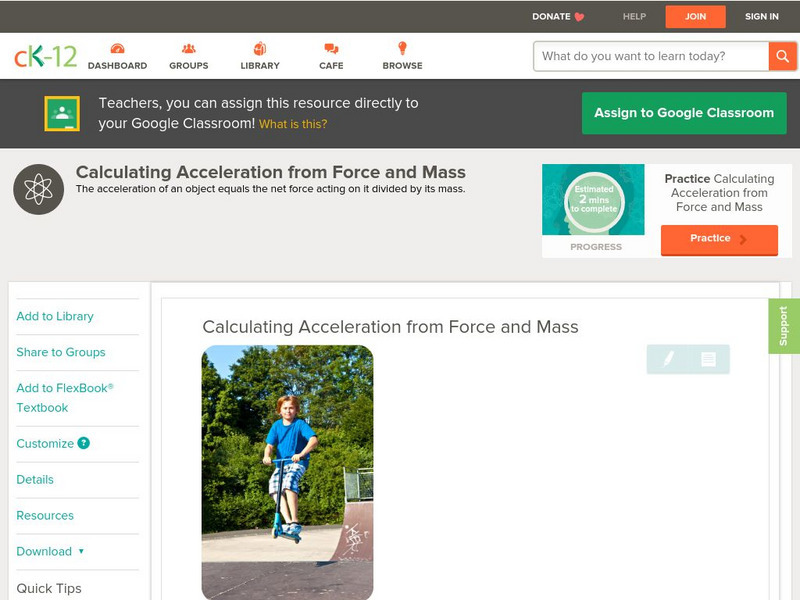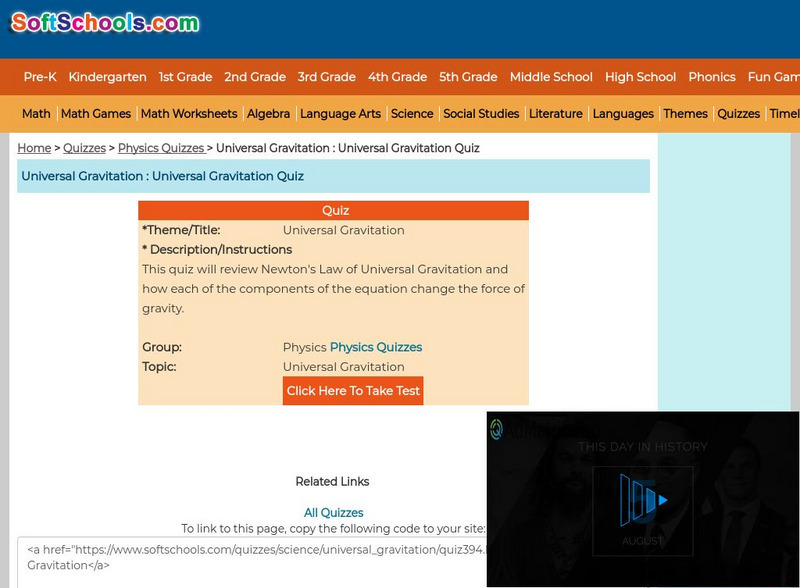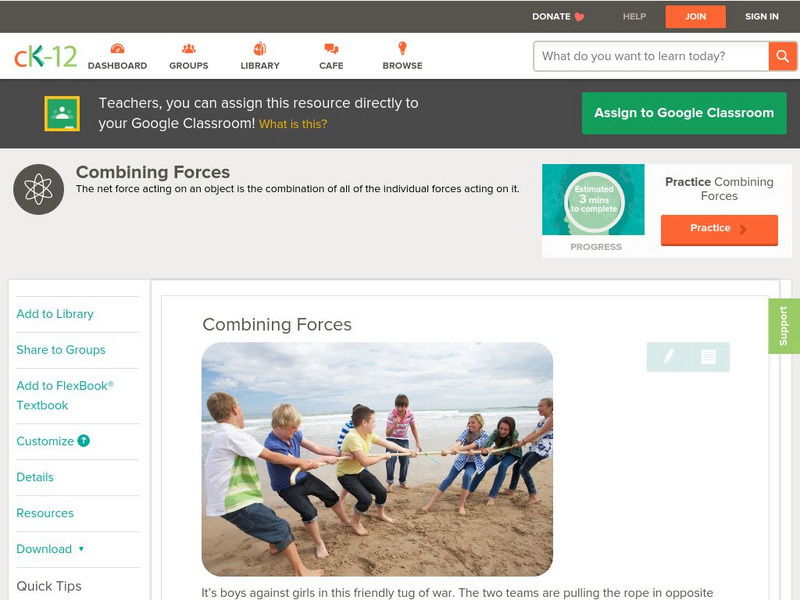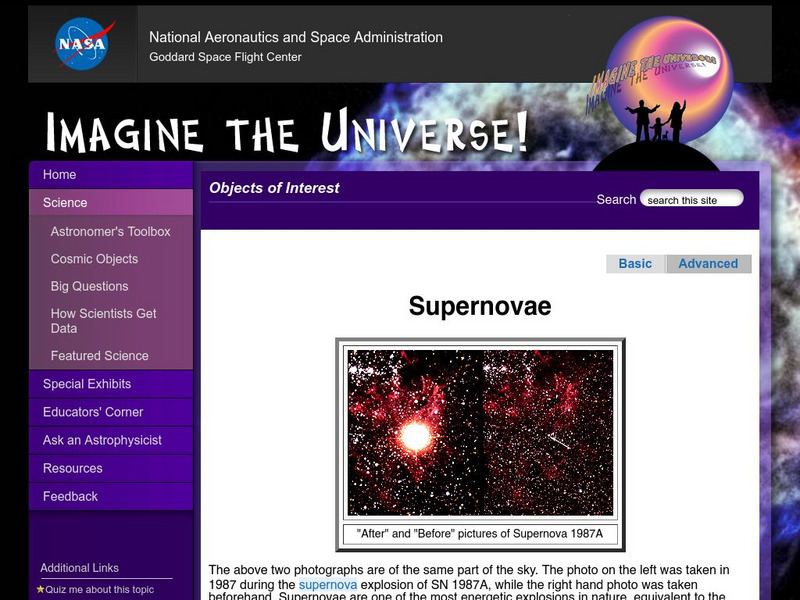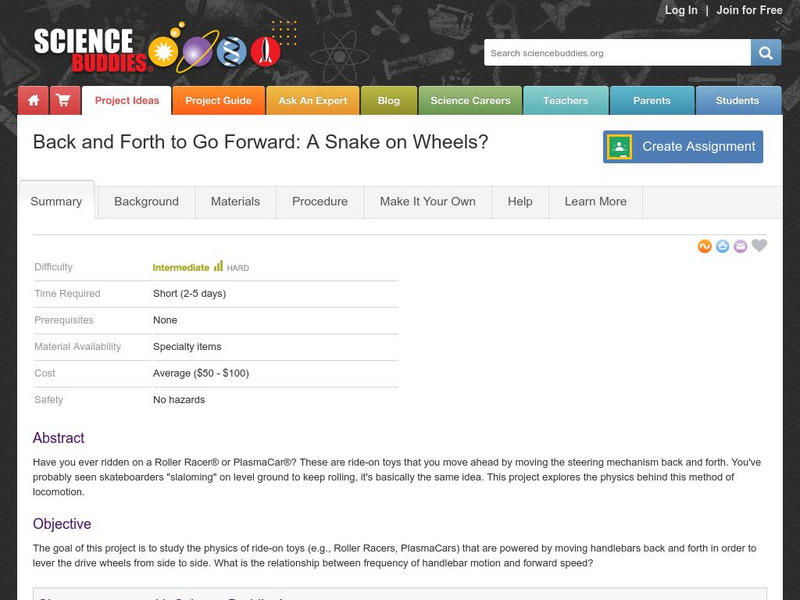Hi, what do you want to do?
NASA
Nasa: Beginner's Guide to Aerodynamics
Includes exhaustive information and a wealth of activities pertaining to aerodynamics and the physics of flight.
Physics Classroom
The Physics Classroom: Satellite Motion
An animation depicting the path of projectiles launched at various launch speeds from the fictional Newton's Mountain. Accompanying text discusses satellite motion and the requirements of orbital motion. Links to further information is...
CK-12 Foundation
Ck 12: Physical Science: Calculating Acceleration From Force and Mass
[Free Registration/Login may be required to access all resource tools.] How to calculate acceleration from force and mass, and force from mass and acceleration.
Physics Aviary
Physics Aviary: Practice Problems: Car on a Turn Problem
Students must determine the force of friction on a car on a turn and the maximum speed the car could navigate a turn.
NASA
Nasa: Vectors
This site from NASA provides an excellent tutorial on vectors and their use in physics to describe the motion of objects. Vector addition and resolution are illustrated.
Soft Schools
Soft Schools: Physics Quizzes: Universal Gravitation
Assess your understanding of Newton's Universal Law of Gravitation with this interactive multiple choice quiz. Immediate feedback is provided.
Georgia State University
Georgia State University: Hyper Physics: Conservation of Energy
This site is from the Physics Department at Georgia State University. The conservation of energy as a fundamental conservation law is presented and compared to other conservation laws (momentum and angular momentum). Links to further...
Physics Classroom
The Physics Classroom: Momentum and Collisions: Cart and Brick Interactive
Students analyze a collision between a moving cart and a dropped brick that lands on top of it. They use position-time data to determine the pre- and post-collision speeds of the cart and the brick. The individual momentum values of the...
Physics Classroom
The Physics Classroom: Momentum and Collisions: Exploding Carts Interactive
Students explore different situations where two side-by-side carts on a low-friction track push away from each other and travel in opposite directions. The goal is to investigate the effects on the relative mass.
Physics Classroom
The Physics Classroom: Momentum and Collisions: Collision Carts Activity 1
A virtual collision track with colliding or exploding carts allows students to explore elastic and inelastic collisions. They can vary the mass of the two carts and their pre-collision velocities. An accompanying activity sheet which...
Physics Classroom
The Physics Classroom: Momentum and Collisions: Collision Carts Activity 2
A virtual collision track with colliding or exploding carts allows students to explore elastic and inelastic collisions. They can vary the mass and velocities of the two carts. An accompanying activity sheet which focuses on elastic...
Physics Aviary
Physics Aviary: Practice Problems: Energy on Incline Level 2
Students must predict the distance a box will move up an incline based on energy conservation. There will be friction present and some of the original KE will turn into heat.
Physics Aviary
Physics Aviary: Practice Problems: Power of Motor for Billy on Hill (Level 1)
Students must determine the power that is being exerted by a motor to pull a person up a frictionless incline.
Physics Aviary
Physics Aviary: Practice Problems: Billy on Hill (Level 2)
Students must predict the distance traveled by a person on a sled. The person will start with potential energy due to gravity and then lose some energy on a hill. They will then lose the remaining energy on a level surface. You have to...
Physics Aviary
Physics Aviary: Atwood Machine Lab
This lab was designed to have students practice the Atwood lab prior to doing it for real. Students can adjust the masses and the planet and then collect position vs. time data and velocity vs. time data.
Physics Aviary
Physics Aviary: Practice Problems: Forces on Incline Problem Medium
Students must find out force normal on an object on an incline at the angle at which the object is first about to slip.
CK-12 Foundation
Ck 12: Physical Science: Combining Forces
[Free Registration/Login may be required to access all resource tools.] Featurea the definition of combining forces: Pulling down and pushing up, forces acting in opposite directions, forces acting in the same direction.
TeachEngineering
Teach Engineering: Flying With Style
As students begin to understand the physics behind thrust, drag, and gravity and how these relate these to Newton's three laws of motion, groups assemble and launch the rockets that they designed in the associated lesson.
OpenStax
Open Stax: Applications of Statics, Including Problem Solving Strategies
From a chapter on Statics and Torque in a Physics textbook. This section of the chapter discusses how statics can be applied in the real world, and strategies for solving statics problems. Includes a question, two exercises, and a...
NASA
Nasa: Imagine the Universe: Supernovae (Advanced)
Supernovae are divided into two basic physical types, including a description of supernova types and how they are classified based on the existence of hydrogen spectral lines. Definitions of key terms are provided.
Science Buddies
Science Buddies: Back and Forth to Go Forward: A Snake on Wheels?
Have you ever ridden on a Roller Racer or Plasma Car? These are ride-on toys that you move ahead by moving the steering mechanism back and forth. You've probably seen skateboarders "slaloming" on level ground to keep rolling, it's...
Physics Central
Physics Central: Physics by the Fire: Match Stick Rocket
Match stick rockets makes a great demonstrations to show students Newton's third law. By covering a match with tin foil, students can see the reaction thrust as the molecules escaping the matchstick are propelled into the air. Lesson...
University of Virginia
Uva Physics: Using Vectors to Describe Motion
Background information on vectors and their use in describing motion in two dimensions. A comparison of Aristotle's and Galileo's perspectives on force and motion is given.
Ducksters
Ducksters: Physics for Kids: Laws of Motion
Kids learn about the science behind the basic three Laws of Motion. Forces theory discovered by Isaac Newton.







